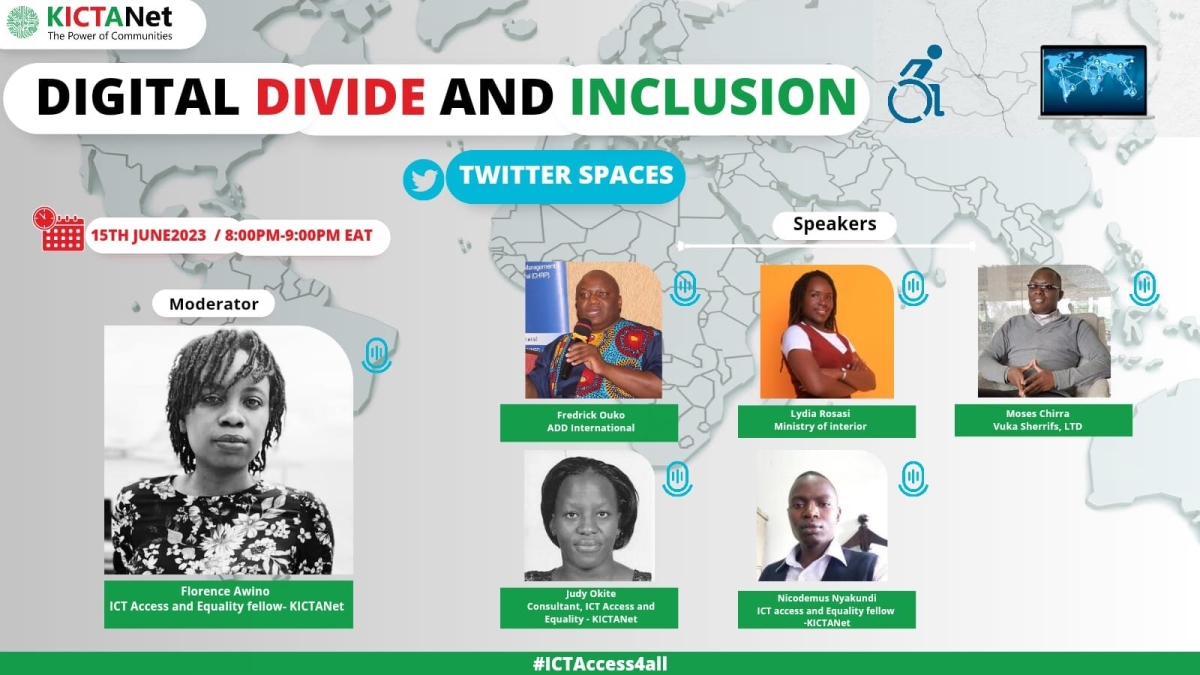In an ideal scenario, where we are now living in a highly connected world, it is critical that the web be usable by everyone regardless of individual capabilities and disabilities. This is a paraphrase of a quote that the founder of the World Wide Web Tim Berners-Lee talked about digital inclusion. It goes on longer than this, but what does digital inclusion mean for persons with disabilities in their different areas of expertise?
The bi-monthly instalment of KICTANet Spaces by the ICT Access and Equality for persons with disabilities fellowship tackled the issues of digital divides and inclusion. The fellowship hosted five thought leaders in the digital inclusion space to share their insights and experiences on the Twitter Space talk.
Nicodemus Nyakundi working with KICTANet as an ICT Access and Equality for persons with disability fellow says that the most pressing barrier he’s observed is lack of digital inclusion. To him this divide comes from the lack of content created in formats that are accessible to persons with disabilities.
There’s also a marked under-inclusion of persons with disabilities in the development of digital platforms where their input would be valuable in developing a product that works for persons with disabilities.
Low representation of persons with disabilities in the ICT space is concerning because new digital platforms and products are rapidly coming. All this is happening without a corresponding increase in implementing accessibility considerations.
The absence of access to technology not withstanding, persons with disabilities sometimes do have low digital literacy that contributes to low uptake of digital technology.
Moses Chiira, who works in the media industry observed that the digital divide is quite profound. He shared that it stems from the lack of knowledge on the availability of software products that are compatible with the assistive devices or tech used by persons with disabilities.
Moses is a journalist but faced significant attitudinal barriers during his training because people were sceptic about him becoming a radio journalist while visually disabled. Despite the naysaying, Moses completed his training and was met with fresh resistance when he wanted to become an audio producer.
Nevertheless, he persisted and researched until he found an audio producing software that was compatible with his JAWS screen reader. There is a lack of knowledge that assistive tech exists that can make inclusion a reality for persons with disabilities in their different professions. Where there is knowledge, the cost of these software programs is another driver of exclusion. The panel heard that many Kenyan employers often preferring not to cater for the costs of acquiring the original premium versions of the assistive software. They prefer to hire employees who do not come with perceived additional expenses.
Frederick Ouko of ADD International spoke about the perception that persons with disabilities are “the poorest of the poor” resulting into a profound effect on their ability to access digital technology. According to Fred, in development ethics this translates to less, minimal, or even no purchasing power around digital tools for persons with disabilities to access information or participate in the digital world. With little purchasing power, cost becomes another barrier to accessibility.
When it comes to access to digital education for children with disabilities, it is often an afterthought. More pressing matters like walking aids or other assistive devices take priority over the families purchasing digital tools like computers or providing the internet unlike their peers. In the end, children with disabilities have to contend with playing catch-up because of the delayed introduction to digital skills. Persons with disabilities constantly being left behind from the beginning creates a divide that may persist throughout their life.
As the discussion went on, the speakers shared that they had either led or undergone various training programs designed specifically for persons with disabilities. This ranged from employability and entrepreneur training, digital upskilling, training in inclusive tech and development of education digital programs.
Despite the spirited efforts to bridge the digital divide in Kenya, there is concern that the digital skills and literacy programs are confined to major cities. This presents various stakeholders with the opportunity to decentralize the programs to reach persons with disabilities living in the rural and marginalized communities.
What are some of the collaborative efforts that the Kenya Government, private sector and civil society organizations and individuals can undertake to enhance the digital inclusion of persons with disabilities? There are people and organizations somewhere who have their digital inclusion efforts right, and we can learn from them. Who are they? Listen to the rest of the conversation here.
Our next Twitter Space will be held in August.
Moderator: Florence Awino Ouma -KICTANet
Speakers:
Fredrick Ouko- ADD International
Nicodemus Nyakundi – KICTANet
Lydia Rosasi – Ministry of Interior
Moses Chiira- Vuka Sherrifs, LTD
Sub
Judy Okite – Consultant, KICTANet
![]()




